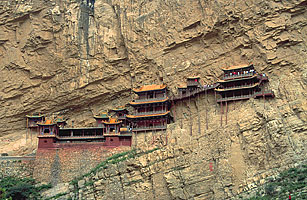
The Xuan Kong Si, or "Hanging Temple," does not so much hang as it does cling to a vast rock face at the foot of Hengshan Mountain in China's Shanxi Province like a cast-off regretting an earlier decision to jump. About 300 miles south west of Beijing, the entire complex — a cluster of yellow-capped pagodas linked by lean planks — is kept in place with wooden crossbeams fitted into holes chiseled into the stone. Flattened against this roughhewn wall, it seems that one splintered log (or an unkind word) could send the temple tumbling off its 75-metre-high cliff. But it has managed to stay put for some 1,400 years, prompting architects and engineers from around the globe to stop in and marvel at its assembly. According to legend, construction began with a single monk, Liao Ran, at the end of the Northern Wei Dynasty. In time he got help from Taoist builders, pleased at the prospect of a distant sanctuary where practitioners could meditate in true silence. They did not count on it becoming a teeming tourist draw.